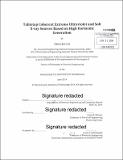Tabletop coherent extreme ultraviolet and soft X-ray sources based on high harmonic generation
Author(s)
Lai, Chien-Jen, Ph. D. Massachusetts Institute of Technology
DownloadFull printable version (14.40Mb)
Alternative title
Tabletop coherent EUV and soft X-ray sources based on HHG
Other Contributors
Massachusetts Institute of Technology. Department of Electrical Engineering and Computer Science.
Advisor
Franz X. Kärtner.
Terms of use
Metadata
Show full item recordAbstract
High harmonic generation (HHG) is a fascinating strong-field physics phenomenon that occurs when a laser pulse with a moderate intensity interacts with atoms and partially ionizes the atoms. A series of harmonics are generated at similar efficiencies and extend to a few tenth, even thousandth, order harmonics at the extreme ultraviolet (EUV) and soft X-ray range. Such an unprecedented broadband and coherent spectrum thus has many novel applications, one of which is to build tabletop coherent EUV and soft X-ray sources. The development of EUV and soft X-ray lasers is very challenging because of the strong absorption of these wavelengths in almost all materials and the lack of appropriate reflection optics. So far, bright coherent EUV and soft X-ray sources are only available at several large-scale facilities, like free-electron lasers. However, the demands for coherent EUV sources is growing due to the advances in atomic physics, chemistry, and material science. Therefore, lab-scale EUV sources are highly desirable for these novel applications and research opportunities, and HHG emerges as a promising technology toward this goal. This thesis will present my PhD work on HHG. It includes the numerical models developed to simulate HHG either on single-atom scale or for a macroscopic medium, the modification to the current theoretical model, the analysis of the influence of plasma defocusing on HHG, the study of the wavelength scaling of HHG efficiency and cutoff with visible and near-infrared (IR) lasers, and the generation of multi-mJ ultrashort mid-IR (2.6 mJ, 39 fs, and 2 tm central wavelength) pulses at kHz repetition rate in the aim of extending the cutoff of HHG. With the kHz mid-IR pulses, an EUV source providing up to 108 photons/sec at 160 eV has been demonstrated, and photons in the water window range have also been detected. At the end, a chapter will summarize these research works and propose some possible future directions.
Description
Thesis: Ph. D., Massachusetts Institute of Technology, Department of Electrical Engineering and Computer Science, 2014. Cataloged from PDF version of thesis. Includes bibliographical references (pages 105-115).
Date issued
2014Department
Massachusetts Institute of Technology. Department of Electrical Engineering and Computer SciencePublisher
Massachusetts Institute of Technology
Keywords
Electrical Engineering and Computer Science.